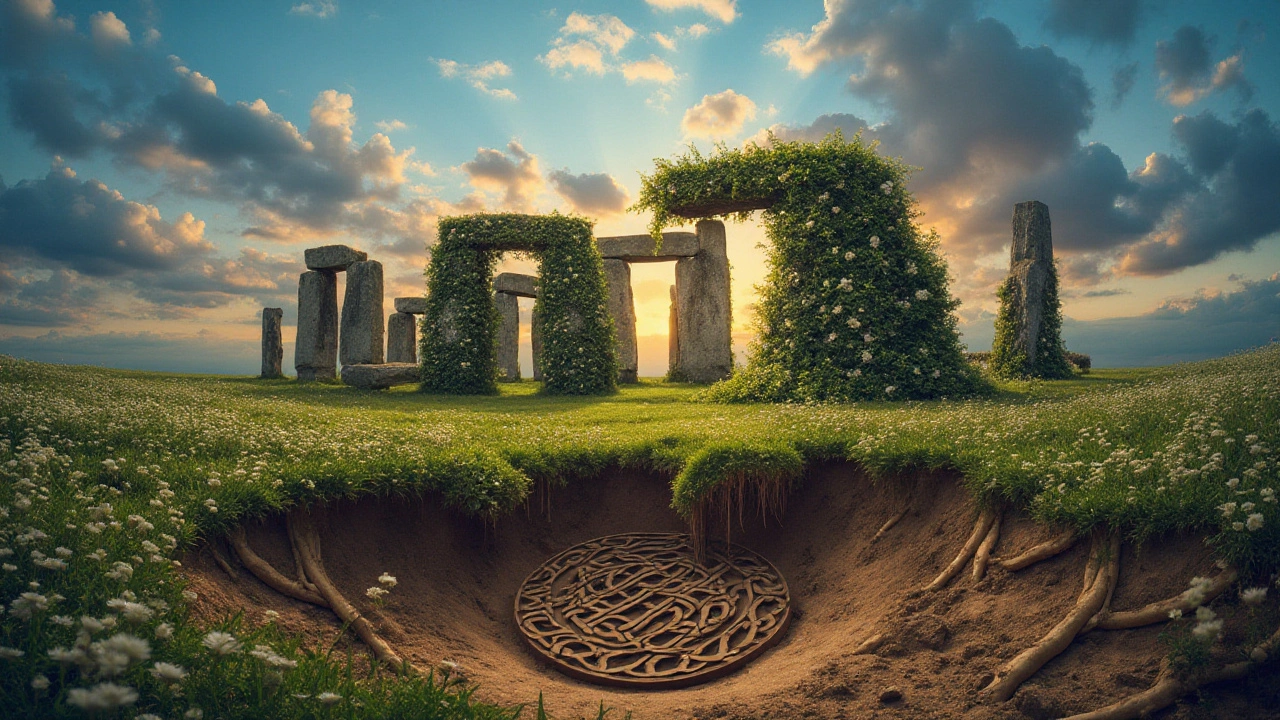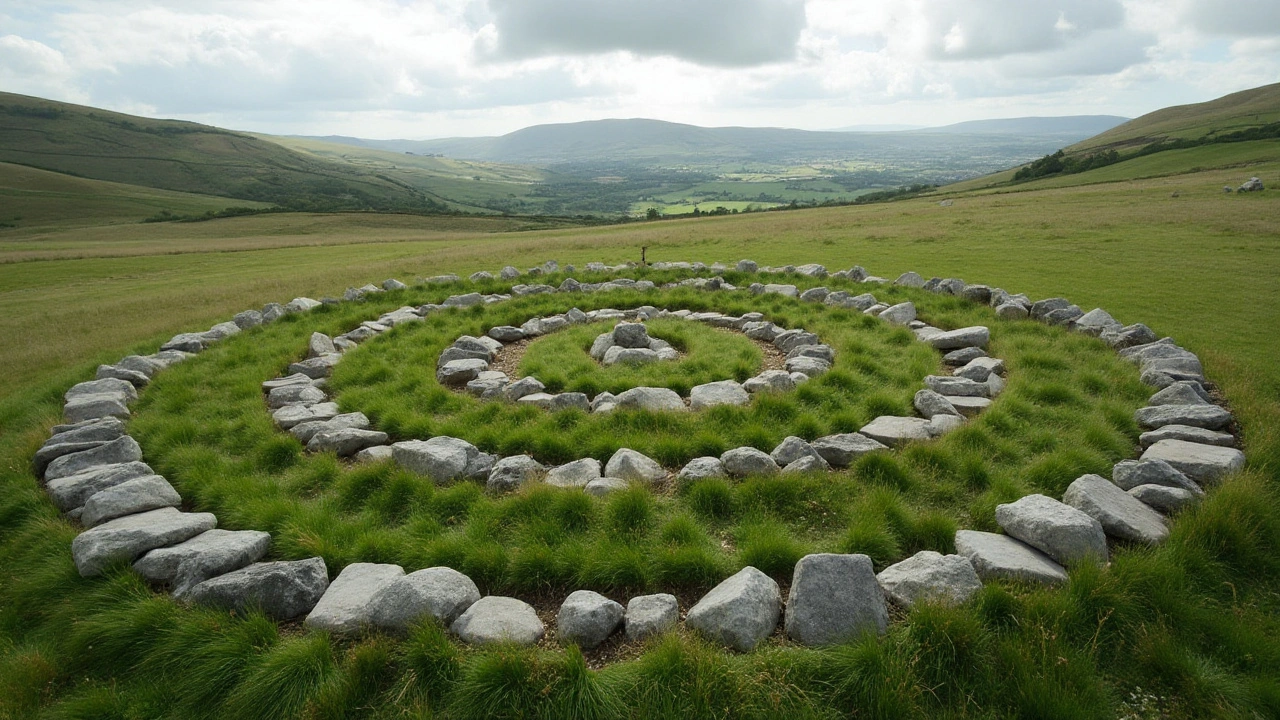Land art, often intertwined with the environment itself, transforms the tapestry of landscapes into breathtaking canvases. Emerging robustly in the late 20th century, this unique form of artistic expression nudges viewers to explore beyond the confines of traditional gallery spaces. Nature becomes not just a backdrop but an integral collaborator in the creative process.
Imagine walking through a desert where the sand patterns speak louder than words, or standing before a spiraling rock sculpture that seemingly defies gravity. This is the magic of land art—the experience of entering a realm where boundaries blur between art and nature, leading us into realms of wonder and introspection. This movement invites a renewed dialogue with our surroundings, urging us toward a more contemplative engagement with the planet.
- Origins and Evolution
- Notable Artists and Iconic Works
- Techniques and Materials
- Environmental Impact and Awareness
- Unseen Challenges
- Tips for Aspiring Land Artists
Origins and Evolution
The story of land art begins in the shifting sands of history, unfurling its creative roots in the tumultuous era of the 1960s. It was a time marked by social upheaval and a palpable thirst for artistic freedom, compelling artists to seek spaces outside the traditional confines of galleries. Confronted by the constraints of white-walled rooms and the commercialization of art, they turned their gaze toward nature's expansive canvas. The desert landscapes of the American West became the fertile ground for this radical movement, where artists could sculpt with earth, stones, and the wind itself.
A pivotal figure in the emergence of land art was Robert Smithson, whose iconic work "Spiral Jetty" still remains a landmark piece. Constructed in 1970 on the northeastern shore of the Great Salt Lake in Utah, the swirling formation of rocks and earth epitomizes the intricate dance between art and its environment. Yet Smithson was not alone in this endeavor. Alongside him, other visionaries like Nancy Holt, Michael Heizer, and Walter De Maria, began crafting immense earthworks that resonated with both grandeur and humility. Nancy Holt once expressed, "My wish is to stay always like this, living quietly in a corner of nature." These words capture the essence of land art's evolution—where the bond between the artist and nature was one of mutual respect and understanding.
The evolution of land art continued through the decades, constantly reshaping its identity. The 1970s and 1980s marked a period of expansion beyond the United States, as artists globalized their perspectives and embraced diverse terrains. In England, Richard Long embarked on forging art through the simple yet profound act of walking, leaving behind traces of footprints in mud or arranging stones. His act of peripatetic art-making introduced a new dialogue where the journey became as significant as the destination.
In the contemporary world of art, the legacy of land art is manifold; it has inspired a new generation of artists committed to environmental consciousness. With climate change surfacing as a pressing global concern, many artists now utilize their work as a platform for ecological advocacy. They blend technology with tradition, employing sustainable practices to ensure that their creations are both impactful and mindful of their footprint. Artworks that incorporate renewable materials or those that are biodegradable represent this shift towards a more sustainable relationship with the Earth.
As land art has matured, its influence is also seen in urban landscapes, breaking down the divide between city and nature. Urban planners and architects draw inspiration from this art form to introduce green spaces in cities—rooftop gardens, living walls, and eco-friendly parks—thereby embedding the principles of land art into everyday life. This evolving relationship indicates a vibrant blend of artistic expression and ecological responsibility, taking Smithson's vision far beyond those initial swirling formations. It reminds us that art is not just an object to be viewed but an experience to be lived—an ethos that land art embodies profoundly and passionately.
Notable Artists and Iconic Works
To truly grasp the essence of land art, it's essential to dive into the world of visionary artists who have etched their creative spirits onto the world's landscapes. At the forefront of this movement is Robert Smithson, whose monumental piece, 'Spiral Jetty,' crafted in 1970, has become synonymous with earthworks. Situated in the Great Salt Lake, Utah, this spiral of basalt rocks stretching into the red-tinted water reflects both the vastness and vulnerability of nature. The artistry lies not only in its construction but in its interaction with the environment as it changes with the lake's levels. This evocative creation invites viewers to ponder the impermanence of life and art itself.
Another Pioneering Force: Nancy Holt
Nancy Holt, an influential figure, expanded creative horizons with her own landmark piece, 'Sun Tunnels.' Installed in the 1970s, it captures the celestial dance between earth and sky through four massive concrete tubes positioned in Utah's desert. Each tube aligns with the sun's path during the solstice, forming a harmonious blend of art and astral observation. Her work challenges our perception of landscape, urging us to recognize the beauty in simplicity and the unseen connection between art and environment. Holt once remarked,"Art, at its best, is a dialogue between materials and form where one invites new ways of seeing the world around us."
Environmental Reflection through Andy Goldsworthy
Moving into the realm of environmental transience, Andy Goldsworthy is revered for his temporary, nature-based sculptures. His creations are a poetic homage to the fleeting moments of life and nature's cycles. Using an eclectic mix of leaves, twigs, stones, and ice, Goldsworthy's art is a testament to nature's ephemeral beauty. One might stumble upon his vibrant leaf arrangements or magnificent stone arches and recognize them as an ode to the earth's transient essence. His pieces gracefully fall apart, leaving no trace, echoing the natural rhythms and cycles of our environment itself.These artists do more than sculpt the earth—they generate deeper dialogues about our place within the natural world. Their iconic works invite us to connect with land through a new lens, urging us to appreciate the world as both an ever-changing canvas and a sacred storyteller. As these creations continue to inspire awe and reflection, they serve as enduring reminders of our shared responsibilities towards the environment.
Techniques and Materials
In the realm of land art, ingenuity knows no bounds. Artists use a diverse array of techniques and materials to craft their ecological masterpieces. Central to this form of art is the philosophy of working in harmony with the environment, which means that each technique is carefully chosen to interact with, rather than dominate, the natural world. Traditional art supplies take a backseat here, as artists opt for materials like rocks, soil, plants, and water. The essence of these elements is celebrated in their raw, unrefined state, amplifying the dialogue between art and nature.
One of the earliest and most captivating techniques is earthworks, which involves altering the landscape itself. Artists like Robert Smithson, famed for his iconic Spiral Jetty, employed bulldozers and earthmovers as his paintbrushes. This technique demands a deep understanding of geology and topography, as artists must consider the long-term effects on the local ecosystem. Another widely used approach is the ephemeral technique, championed by artists like Andy Goldsworthy. By assembling natural objects with a sensitivity to flow and balance, these creations are destined to be changed or destroyed by the elements.
Water plays a special role in many land art pieces, often reflecting and refracting light in their installations. This element can be seen in works such as Walter De Maria's The Lightning Field, where the vast New Mexico desert serves as both setting and source of inspiration. This installation uses stainless steel poles to capture and interact with the unpredictable dance of lightning storms. Land artists are inventive, using everything from fragile icicles to towering rock formations. The ability to envision the potential of these earthworks is what sets artists apart in this genre.
"What I recognize in art is its ability to challenge us to think differently about our environment," mused Richard Long, another prominent land artist, emphasizing the reflective nature that lies in such works.
In recent years, the advent of technology has expanded the horizons of environmental art. Some artists incorporate digital media and augmented reality to enhance the viewer's experience, bridging the gap between the virtual and natural worlds. This melding of cutting-edge technology with land art transforms traditional concepts of space and perception. Sensors, drones, and time-lapse photography are increasingly common tools used to document and even guide the process of creating art that is in conversation with the earth. These advancements open up new possibilities for land artists, challenging them to redefine their boundaries continually.

Environmental Impact and Awareness
Land art brings something truly extraordinary to the table by integrating nature within the artistic process. Artists don’t just create works; they forge connections with the environment, leading to a profound impact on ecological awareness. The shaping of natural landscapes into imaginative earthworks often emphasizes the fragility and beauty of our planet. People drawn to the spectacle of these awe-inspiring installations begin to consider their own place in the ecosystem. This art movement, which includes the likes of Andy Goldsworthy and Richard Long, demonstrates how creativity can underscore the urgency of environmental conservation. By using materials like stones, leaves, and soil, artists craft narratives that speak to the intrinsic relationship between art and the Earth itself.
Environmental implications are a central theme in the discourse surrounding land art. While some critics argue about the potential ecological disruption that such grand alterations can imply, many artists handle this matter with a conscientious approach. For example, Michael Heizer’s "Double Negative," which involves enormous trenches carved into the Nevada desert, prompts discussions about the balance between artistic expression and environmental stewardship. Such works aren’t created in a void but often during a dialogue with the local landscapes. Importantly, the rise of the movement sheds light on the significance of sustainable art practices. Artists frequently aim to leave minimal lasting impact on their surroundings, often using biodegradable materials or temporary installations that fade naturally back into the landscapes they adorned.
The environmental impact of land art sometimes extends beyond the artwork itself. Many works become conversations about environmental issues, often highlighting themes of climate change and habitat destruction. This genre of art provides a significant platform for advocacy, using the stark beauty and boldness of the artworks to emphasize urgent ecological themes. By capturing the public's imagination and empathy, land art can inspire meaningful action, encouraging individuals to rethink their relationship with nature and how they contribute to its conservation. Highlighting specific projects, the 'Broken Circle/Spiral Hill' by Robert Smithson remains influential, demonstrating how the aesthetics of land art can mirror natural processes and engage viewers in pressing discussions. It's through installations like these that artists urge audiences to reflect on the environmental impact of human activities.
Efforts to promote environmental awareness through land art aren’t just limited to artistic circles. They intersect with educational and scientific communities to foster a broader understanding of ecological themes. Collaborative projects can help share the message of ecological awareness with younger generations, igniting interest and understanding from a grassroots level. Workshops and interactive exhibitions often accompany land art installations to engage visitors more deeply, turning art appreciation into an educational experience. Here, environmental impact is not merely about observing changes in the landscape but about recognizing changes within ourselves in response to these observations. Such initiatives broaden the art's reach beyond traditional spectatorship, making education an active component of environmental consciousness.
While economic factors sometimes influence the production and placement of land art, there is a burgeoning movement towards aligning artistic goals with sustainable practices. As awareness grows, artists and patrons alike consider ecological footprints with greater diligence than ever before, making sustainability a guiding principle in art creation. As evidenced by successful projects worldwide, such as Maya Lin's 'Ghost Forest', which utilizes dead trees in a visual storytelling about climate impact, the nexus of land art and environmental action gains tangible and lasting influence. Art becomes a beacon for change, demonstrating the potential of creativity as a vehicle for environmental stewardship.
According to esteemed critic and curator Lucy Lippard, "The best land art links conceptual creativity with ecological necessity, offering a poignant dialogue on the urgency of environmental preservation."This reflection impresses upon us the power and responsibility wielded by land artists, whose work navigates the delicate line between natural aesthetics and advocacy. The relationship between land art and environmental awareness continues to solidify as an indispensable part of both the art world and environmental activism, inspiring artists and audiences to tread thoughtfully and creatively on the planet we share.
Unseen Challenges
Embarking on a land art project is akin to engaging in a dance with nature, perennially unpredictable and often obstinate. One of the primary challenges land artists confront is the sheer unpredictability of the natural environment. Weather conditions can dramatically affect the start time and progression of a project. A sudden bout of rain or a shift in wind direction can alter the stability of an earthwork or the appearance of an artistic landscape in an instant. This unpredictability requires artists to continually adapt, ensuring their environmental art remains resilient against nature's whims.
Another pressing challenge is the accessibility of chosen locations. Many land art projects are situated in remote, hard-to-reach locations, requiring considerable effort for transportation of materials and labor. The planning phase becomes crucial, as logistics often need meticulous coordination. Ensuring that all necessary materials reach the site intact while leaving no lasting damage on the environment demands careful consideration from the artist. This meticulous preparation involves a substantial amount of research and groundwork, often stretching the bounds of patience and tenacity for those involved.
It is not just mother nature that artists must contend with. There's the matter of legal and environmental regulations. Every piece of earthworks intertwines with ecological sanctuaries and may disturb local biodiversity. Navigating these legislative mazes becomes an integral part of the artistic journey. Many artists engage in dialogue with environmental agencies to ensure their work respects local habitats. A quote from the renowned artist Andrew Goldsworthy underlines this sentiment,
"Working with nature is not just about transforming it; it's about understanding and respecting it."
The fragility of the materials used demands a nuanced approach to construction and maintenance. Natural elements such as stones, wood, and soil are susceptible to erosion over time. Artists often face the arduous task of finding the right balance between maintaining the integrity of a piece and letting it naturally decay, contributing to its unique, ephemeral beauty. The philosophy that decay is an artistic process is embraced by some, yet poses a challenge in documenting and preserving artistic landscapes for future generations.
Funding can also represent a significant hurdle. Unlike mainstream art, which often finds a home in galleries with ample financing, land art seldom attracts the same level of investment. This can make it difficult for aspiring land artists to bring their visions to life. Many rely on grants, subsidies, or even personal funds. The risk is considerable, but the resulting masterpiece, intimately tied to the land, can often redefine what art means both to the artist and to the audience who witness it.
With the added complexity of climate change, land art becomes an even more nuanced endeavor. Artists must grapple with how shifting climates impact their materials and the longevity of their works. Increased storms and altered rainfall patterns might transform these creations, perhaps even erasing them before they reach their full potential. While some might shy away from such unpredictability, it only invigorates the mission of artists determined to communicate the pressing need to recognize and mitigate our impact on the natural world.
Tips for Aspiring Land Artists
Embarking on a journey as a land artist can be both exhilarating and daunting. The stunning landscapes that await transformation can often feel overwhelming, especially for those starting their journey. One of the first pieces of advice is to deeply immerse yourself in the land you wish to transform. Spend ample time exploring and understanding the terrain. Every landscape tells a story, from its unique soil composition to the way sunlight plays on its surfaces throughout the day. Drawing inspiration from the land's innate characteristics can provide a powerful foundation for your work.
Equally important is the choice of materials. Successful land art often relies on using natural elements, such as stones, wood, and earth, to form creations that resonate with the environment. It’s vital to select materials that not only enhance the aesthetic appeal but also respect the ecosystem. This respect is paramount given the increasing awareness of environmental impacts. Always consider how your work will change over time, weathering naturally or being reclaimed by nature. As famous land artist Andy Goldsworthy advises, understanding transience is key: “Each work grows, stays, decays—integral parts of a cycle which the photograph shows at its heights.”
A budding land artist must remain open to experimentation. Experiment with different techniques, from large earthworks involving excavation to quieter, ephemeral pieces using leaves or ice. Each project can be a lesson, honing skills and insights. New artists should consider creating a series of smaller pieces before tackling larger projects. This allows for the cultivation of ideas and techniques in manageable scope. Networking with experienced artists can also offer invaluable learning opportunities. Attend workshops and exhibitions, where dialogue with peers can spark new ideas.
Navigating challenges is part of the artistry journey. Understand that trials will reveal themselves, from bureaucratic red tape when working on public lands to the unpredictability of natural elements. Developing problem-solving skills is as critical as artistic vision. Consider collaboration with environmental scientists or ecologists who can offer expertise on preserving natural habitats, ensuring that your art enriches rather than detracts from the world around it. Joining art communities, whether through online forums or local groups, provides a support network. These communities can be a beacon when facing the unique hurdles that land artists often encounter.
"Land art encourages us to stop and look at our surroundings in a new way." - Michael Heizer
Lastly, remember the storytelling aspect of art. Each piece should not only reflect your personal expression but also engage viewers, evoking a dialogue about the environment and our place within it. Incorporating narratives or themes that speak to climate change or cultural heritage can elevate your works, adding layers of meaning. Document your projects through photography or video, capturing the evolution of your creations. This not only preserves the transient nature of earthworks but also allows you to share your journey and inspire others.




